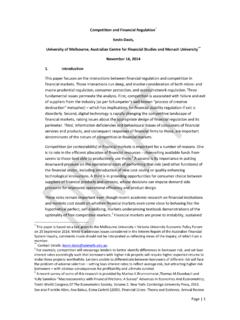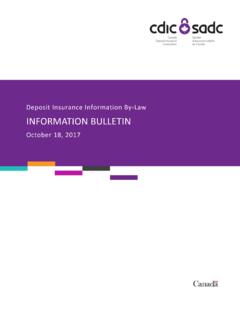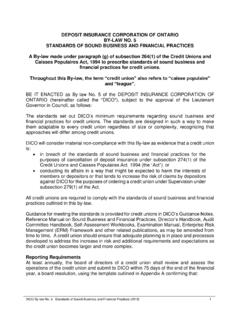Transcription of Depositor Preference, Bail-in, and Deposit Insurance ...
1 Depositor Preference, Bail-in, and Deposit Insurance pricing and design Kevin Davis *. Department of Finance, University of Melbourne and Australian Centre of Financial Studies and Monash University Draft: 30 April 2015. Abstract This paper considers how current developments in Depositor preference and resolution arrangements affect Deposit Insurance scheme design and pricing and argues that they substantially reduce the merits of the conventional view that ex ante risk based premiums are desirable. Depositor preference arrangements can, in many circumstances, reduce the fair value of Deposit Insurance and the risk to the Insurance fund to virtually zero, because other subordinated bank stakeholders are, effectively, providing the Insurance .
2 Banks might be expected to incur the cost of some depositors being protected through higher returns demanded by subordinated stakeholders, and explicit fees for Deposit Insurance would then involve unwarranted duplicate costs. However, if implicit guarantees are believed to exist banks would not face such costs. The appropriate approach is then to charge fees for those implicit guarantees based on total liabilities, such as to finance a resolution fund , rather than fees on insured deposits above the fair value (of zero) for the explicit Insurance . KEYWORDS: Deposit Insurance , Bail-in, Implicit Guarantees, Depositor Preference, Option pricing , Resolution Funds.
3 JEL Categories: G21, G28. *. Contact details: +61 3 8344 5098. Introduction It is the conventional wisdom that: (a) an explicit, limited, well designed, Deposit Insurance scheme (DIS) should be a feature of financial system design ; and (b) one component of good design is the charging of risk adjusted premiums to banks covered by the scheme. There is also a widespread perception that ex ante premiums should be charged to member banks, which is reflected in practice. Among FSB member jurisdictions with an explicit DIS, a considerable number (16) have built up an ex-ante fund . in response to a growing trend in funding patterns around the world.
4 (FSB, 2012). But there is less evidence in the academic or policy literature on the merits of ex ante rather than ex post funding. Demirg -Kunt, Kane, and Laeven (2006) spell out six core principles which include limited coverage, a design which prevents taxpayer loss (except in extreme circumstances), and appropriate risk-based pricing , but do not explicitly include charging ex ante premiums in those principles. The IMF (2013) argues for risk related premiums, but notes strengths and weaknesses of ex ante versus ex post scheme funding. IADI (2014) present principles of Deposit Insurance design which, while endorsing adequate scheme funding arrangements and reduction of moral hazard, do not specifically endorse either ex ante premiums or risk based premiums.
5 Nevertheless, the FSB. (2012) suggests that there may be merits to the broader adoption of ex-ante funding arrangements, and IADI should consider whether a pre-funded DIS needs to be more explicitly advocated in its guidance . That, of course, requires some methodology for determining appropriate fees, and most researchers turn automatically to using some variant of the fair pricing option approach introduced by Merton (1974). The thesis of this paper is that changes in Depositor preference and resolution arrangements underway internationally significantly weaken (if not destroy) the case for charging ex ante Deposit Insurance premiums calculated using fair pricing techniques, and that Deposit Insurance design needs to take into account the nature of preference arrangements.
6 ( Depositor preference, discussed in detail in Section 1 involves all, or some (eg insured), depositors being given seniority over other creditors (such as bond holders) in the event of bank insolvency.) Legislated preference for domestic depositors also creates complications for Deposit Insurance design and the choice of type of presence (branch or subsidiary) for foreign banks. 1. Notably the Financial Stability Board thematic review of Deposit Insurance (FSB, 2012) did not consider Depositor preference, even though the treatment of depositors in the creditor hierarchy can have a profound impact on the costs incurred by the Deposit insurer and the failure resolution regime more generally (IADI, 2014).
7 Relevant to this, IADI's November 2014 revision of core principles IADI (2014), includes principle which proposes that the Deposit insurer has at least the same creditor rights or status as a Depositor in the treatment in law of the estate of the failed bank . As shown later, this is not the case in a number of jurisdictions, but in an increasing number of cases the Deposit insurer ranks ahead of uninsured depositors. 1. In September 2012, the UK Financial Services Authority released a consultation paper (FSA, 2012) suggesting that banks from non-EEA countries with national Depositor preference would be required to adopt a subsidiary rather than branch presence in the UK to protect UK depositors with those banks.
8 At April 2015, the timetable for implementation had yet to be announced. 1|Page Particularly in those latter cases, the fair value of official explicit Deposit Insurance approaches zero, rendering the conventional wisdom for ex ante risk based premiums invalid. But, if perceptions of bail-out remain amongst uninsured bank depositors and creditors, there is a case for levies based on total liabilities, which can be used for a resolution fund . Such levies can be calculated using a methodology which can be found in Merton (1974), but which is different to the fair pricing technique also articulated there, and which has influenced most subsequent research.
9 The argument can be stated briefly as follows. First, Depositor preference and bail-in debt requirements mean that, under reasonable assumptions, the fair price , reflecting the value of taxpayer / Insurance fund guarantees to insured depositors is extremely close to (if not equal to). zero. 2 (The exception is if the proportion of insured deposits in total bank liabilities is very high.). Second, uninsured depositors and other creditors should, in these circumstances, demand appropriate risk-based returns for the Insurance they provide, via subordination, to insured . depositors. 3 Such market discipline would overcome the moral hazard concerns associated with having no explicit Deposit Insurance fee.
10 Third, however, if this form of market discipline does not operate due to perceptions of implicit government guarantees 4, a fee reflecting the value of those implicit guarantees is appropriate (on grounds of both moral hazard prevention and competitive neutrality). Such fees could be used for a resolution fund such as exists in some jurisdictions, enabling regulators to arrange takeovers of troubled institutions, or use of other mechanisms, which, by their nature, provide protection to other creditors as well as insured depositors. While an option pricing approach could be used to calculate the appropriate size of fee for implicit guarantees, it is unrelated to determination of a fair premium for explicitly guaranteed deposits .






